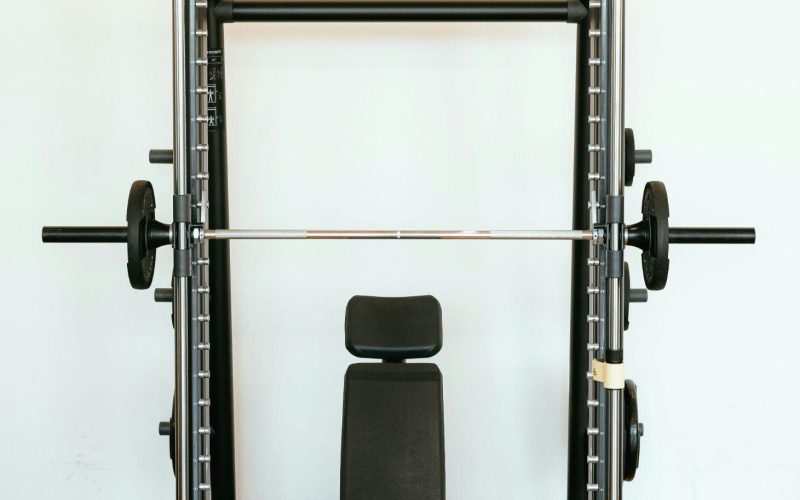Power racks are a versatile tool for strength training, offering safety and stability for lifting heavy weights. This guide explores key exercises to maximise your power rack workouts.
Understanding Power Racks
A power rack is a cage-like structure with adjustable uprights and safety features like spotter arms. These features allow you to lift with confidence, pushing yourself to build strength and muscle.
Benefits of Power Racks
- Safety: Safety pins catch the barbell if you fail a rep, minimising injury risk.
- Stability: The rack provides a stable platform for exercises like squats and bench press.
- Versatility: Power racks often have pull-up bars, dip bars, and other attachments for various exercises.
Top 6 Power Rack Exercises
- Squats: The king of lower body exercises, squats target quads, hamstrings, glutes, and calves. The power rack allows safe squatting with heavy weights.
Enhance your power rack workouts with squat variations:
- Goblet Squats: Hold a dumbbell or kettlebell in front of your chest to target quads, glutes, and core.
- Front Squats: Emphasise quads and core by resting the barbell on the front of your shoulders.
- Bulgarian Split Squats: Target quads, glutes, hamstrings for improved balance and stability.
- Pistol Squats: Strengthen quads, glutes, core with this balance-demanding variation.
- Bench Press: A classic upper body exercise, the bench press targets the chest, shoulders, and triceps. The power rack provides stability for lifting heavier weights.
The bench press targets chest, shoulders, and triceps. Using a power rack for bench press ensures safety, stability, and allows for lifting heavier weights to build upper body strength.
Steps for bench press in a power rack:
- Set safety pins just below chest level.
- Position the barbell at arm’s length.
- Lie down so the bar is above your eyes.
- Lower the bar to your chest.
- Push back up, fully extending arms.
- Repeat for desired reps.
Maintain proper form and technique to prevent injury and maximize effectiveness while performing the bench press exercise.
- Pull-Ups/Chin-Ups: These compound exercises target the back, biceps, and shoulders, and improve core stability. The power rack allows for proper form and technique.
Pull-ups and chin-ups target the back, biceps, and shoulders, engaging core muscles for strength and stability. Use a power rack for stability and focus on form:
- Set up the pull-up bar at the right height.
- Grab the bar with an overhand (pull-ups) or underhand grip (chin-ups).
- Hang with arms extended and core engaged.
- Pull up until your chin clears the bar.
- Slowly lower back down.
- Repeat for desired reps.
- Overhead Press: This exercise strengthens shoulders and triceps. The power rack allows for a greater range of motion and provides safety.
The overhead press, or military press, targets shoulder and tricep muscles. It’s key for upper body strength and stability. Using a power rack enhances range of motion and safety.
To do the overhead press in a power rack:
- Set safety pins just below shoulder level.
- Place the barbell at shoulder height.
- Stand in front of the bar, grip it slightly wider than your shoulders.
- Lift the bar overhead, arms fully extended.
- Lower the bar to shoulder level, elbows slightly bent.
- Repeat for desired reps.
Incorporating this exercise boosts shoulder strength and overall upper body power.
5. Barbell Rows: Barbell rows target the back muscles, promoting overall development. The power rack allows for safe and controlled execution. Barbell rows target back muscles for complete development, engaging lats, rhomboids, traps, biceps, forearms, and core.
- Set up the bar in a power rack at the right height.
- Stand with feet shoulder-width apart, hinge at the hips to grab the bar with an overhand grip, and maintain a neutral spine.
- Pull the bar towards your lower chest while keeping your back straight and squeezing your shoulder blades together.
- Lower the bar in a controlled manner and repeat.
- Focus on maintaining proper form and gradually increase weight as you get stronger.
6. Deadlifts: Deadlifts are a full-body exercise that tests overall strength. The power rack allows for a safe setup and easy loading/unloading of weights.
For safe deadlifts on a power rack:
- Adjust J-hooks or uprights to mid-shin level.
- Place the barbell aligned with J-hooks.
- Approach bar with shoulder-width stance, flat back.
- Grasp bar just outside shoulder-width.
- Push through heels to lift the bar, maintaining form.
- Lower bar in controlled manner, touch floor between reps.
Advanced Power Rack Exercises:
Once you’ve mastered the foundational exercises, the power rack opens doors to more targeted movements for sculpted physiques and increased strength.
- Pin Squats: Set the safety pins just below your sticking point in a squat. This eliminates momentum and forces you to build power through the entire movement, strengthening specific weaknesses.
- Safety Squat Variations: Utilise the safety pins for front squats, overhead squats, or Bulgarian split squats. These variations target different muscle groups while maintaining safety with heavy weights.
- Incline/Decline Bench Press: Adjust the rack benches for incline or decline variations of the bench press. This emphasises the upper or lower pec muscles, respectively, for a more complete chest workout.
- Landmine Exercises: Attach a barbell landmine attachment to the rack. This allows for unique exercises like single-arm rows, shoulder presses, and rotational movements that challenge core stability and improve overall athleticism.
Power Rack Training Tips:
- Warm-up: Before lifting heavy weights, perform dynamic stretches and light weight exercises to prepare your muscles and joints.
- Progression: Gradually increase weight, sets, and reps as you get stronger. Don’t sacrifice form for heavier weights.
- Mind-Muscle Connection: Focus on the targeted muscle group during each exercise for optimal results.
- Rest Periods: Allow sufficient rest (usually 1-3 minutes for compound lifts) between sets to recover and maintain proper form.
- Form Check: Use a mirror or video recordings to ensure proper form and avoid injuries.
By incorporating these exercises, advanced variations, and training tips, you can transform your power rack workouts into a well-rounded program for building strength, muscle mass, and overall fitness. Remember, consistency and proper technique are key to unlocking the full potential of power rack training.
Conclusion
Power rack exercises can significantly enhance your strength training. Master the proper techniques for these exercises to maximise your workouts and achieve your fitness goals. Remember to focus on form and control to get the most out of your power rack training.









